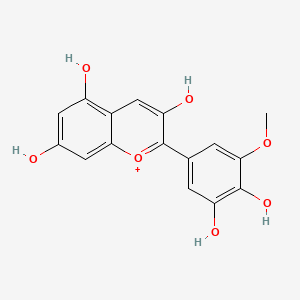| Authors | Title | Published | Journal | PubMed Link |
|---|---|---|---|---|
| Philpott M et al. | Dietary protection against free radicals: a case for multiple testing to establish structure-activity relationships for antioxidant potential of anthocyanic plant species. | 2009 | Int J Mol Sci | pmid:19399239 |
| Laitinen RA et al. | Identification of target genes for a MYB-type anthocyanin regulator in Gerbera hybrida. | 2008 | J. Exp. Bot. | pmid:18725377 |
| Trost K et al. | Anthocyanin degradation of blueberry-aronia nectar in glass compared with carton during storage. | 2008 | J. Food Sci. | pmid:19019128 |
| Azuma K et al. | Structures and antioxidant activity of anthocyanins in many accessions of eggplant and its related species. | 2008 | J. Agric. Food Chem. | pmid:18831559 |
| Zhang J et al. | Determination of anthocyanins and exploration of relationship between their composition and petal coloration in crape myrtle (Lagerstroemia hybrid). | 2008 | J Integr Plant Biol | pmid:18713426 |
| Wang SY et al. | Fruit quality, antioxidant capacity, and flavonoid content of organically and conventionally grown blueberries. | 2008 | J. Agric. Food Chem. | pmid:18590274 |
| Somerset SM and Johannot L | Dietary flavonoid sources in Australian adults. | 2008 | Nutr Cancer | pmid:18584477 |
| Wang CY et al. | Increasing antioxidant activity and reducing decay of blueberries by essential oils. | 2008 | J. Agric. Food Chem. | pmid:18442248 |
| Griesser M et al. | Multi-substrate flavonol O-glucosyltransferases from strawberry (Fragaria x ananassa) achene and receptacle. | 2008 | J. Exp. Bot. | pmid:18487633 |
| Alcalde-Eon C et al. | Identification of dimeric anthocyanins and new oligomeric pigments in red wine by means of HPLC-DAD-ESI/MSn. | 2007 | J Mass Spectrom | pmid:17511019 |
Petunidin
Petunidin is a lipid of Polyketides (PK) class. Petunidin is associated with abnormalities such as Vitamin A Deficiency, Night Blindness, Blind Vision, Chronic Disease and Heart Diseases. The involved functions are known as Drug Interactions, selective breeding, Signal Transduction, Protective Agents and Evolution. Petunidin often locates in Membrane, Body tissue, Gastrointestinal tract structure, Blood and Hepatic. The associated genes with Petunidin are TP53 gene, Genome and Genome, Human. The related lipids are Steroids and Total cholesterol. The related experimental models are Knock-out, Disease model and Animal Disease Models.
Cross Reference
Introduction
To understand associated biological information of Petunidin, we collected biological information of abnormalities, associated pathways, cellular/molecular locations, biological functions, related genes/proteins, lipids and common seen animal/experimental models with organized paragraphs from literatures.
What diseases are associated with Petunidin?
Petunidin is suspected in Chronic Disease, Obesity, Diabetes Mellitus, Non-Insulin-Dependent, Vitamin A Deficiency, Night Blindness, Blind Vision and other diseases in descending order of the highest number of associated sentences.
Related references are mostly published in these journals:
| Disease | Cross reference | Weighted score | Related literature |
|---|
No disease MeSH terms mapped to the current reference collection.
PubChem Associated disorders and diseases
What pathways are associated with Petunidin
There are no associated biomedical information in the current reference collection.
PubChem Biomolecular Interactions and Pathways
Link to PubChem Biomolecular Interactions and PathwaysWhat cellular locations are associated with Petunidin?
Visualization in cellular structure
Associated locations are in red color. Not associated locations are in black.
Related references are published most in these journals:
| Location | Cross reference | Weighted score | Related literatures |
|---|
What functions are associated with Petunidin?
Related references are published most in these journals:
| Function | Cross reference | Weighted score | Related literatures |
|---|
What lipids are associated with Petunidin?
Related references are published most in these journals:
| Lipid concept | Cross reference | Weighted score | Related literatures |
|---|
What genes are associated with Petunidin?
Related references are published most in these journals:
| Gene | Cross reference | Weighted score | Related literatures |
|---|
What common seen animal models are associated with Petunidin?
Knock-out
Knock-out are used in the study 'How can research on plants contribute to promoting human health?' (Martin C et al., 2011).
Disease model
Disease model are used in the study 'How can research on plants contribute to promoting human health?' (Martin C et al., 2011).
Animal Disease Models
Animal Disease Models are used in the study 'How can research on plants contribute to promoting human health?' (Martin C et al., 2011).
Related references are published most in these journals:
| Model | Cross reference | Weighted score | Related literatures |
|---|
